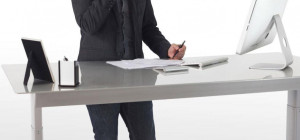 Osteoarthritis is the process of degeneration of cartilage inside our joints as time passes. Cartilage may be the protective element that coats the ends of bones where they come in contact with one another in your joints. Osteoarthritis can often be referred to as “wear and tear” arthritis and is often referred to simply as “arthritis”. Coping with arthritis is usually a challenge, nonetheless, it could be managed with an excellent exercise program.
Osteoarthritis is the process of degeneration of cartilage inside our joints as time passes. Cartilage may be the protective element that coats the ends of bones where they come in contact with one another in your joints. Osteoarthritis can often be referred to as “wear and tear” arthritis and is often referred to simply as “arthritis”. Coping with arthritis is usually a challenge, nonetheless, it could be managed with an excellent exercise program.
What exactly are the symptoms of Osteoarthritis?
Pain: pain is often described as an “ache” and can be there at rest or with movements of the afflicted joint
Inflammation: noticeable swelling and warmth to touch could be present around the afflicted joint
Joint Stiffness: the damaged joint may look stiff and hard to move after periods of inactivity (especially very first thing each morning)
Tenderness: you might find the region around the afflicted joint is tender or painful to press on
Reduced Flexibility: the damaged joint may lose several flexibilities and certain activities like crouching downwards or getting away from a car are more difficult
Reduced Strength: you may find some of the things you employed to manage to do with the affected joint are more difficult due to reduced durability in the muscles encircling it. Physio Bangalore has the best services to provide.
Crepitus: you might hear pops, clicks, and crackles when moving the damaged joint
What joints are afflicted by Osteoarthritis?
Osteoarthritis most commonly affects the knees and hips but may also have an impact on the joints in our hands and spine.
How is Arthritis diagnosed?
X-rays: Cartilage damage is revealed by a good narrowing of the space between the bones found in your joint. As stated in one of our previous blog page posts, an analysis of Osteoarthritis from an X-Ray does not necessarily mean it’s the source of your symptoms. Sometimes, X-Rays reveal Osteoarthritis in joints that look perfectly regular! When Osteoarthritis features progress to more extreme amounts, there are many of treatment options available.
Magnetic resonance imaging (MRI): An MRI visualizes comprehensive images of bone and soft tissues including cartilage. An MRI isn’t typically utilized to diagnose osteoarthritis but might help provide more info in more technical cases.
Blood checks: Although there’s no specific blood check for Osteoarthritis, certain markers in your bloodstream can help eliminate other inflammatory factors behind joint soreness such as for example Rheumatoid Arthritis.
What are some great benefits of Exercise for Osteoarthritis?
Although there are many treatments designed for Osteoarthritis, research demonstrates exercise is the very best non-pharmacological treatment for lessening pain and bettering function in patients. Particularly, exercise improves joint range of motion, muscle overall flexibility and strength. This helps to improve the body’s ability to approach unencumbered and enhances overall balance to prevent falls. Exercising might help manage excess fat, improve disposition and protect the maturing body from other health issues. Physio Bangalore.
While you may fret that performing exercises with Osteoarthritis could harm your joints and cause extra pain, the opposite is really true. When granted a personalized exercise program tailored to their specific needs, sufferers will be able to prolong the need for joint replacement medical procedures and make contact with their activities a lot more quickly.
Exercises For Osteoarthritis
The basic elements of an exercise program for Osteoarthritis are activities that improve flexibility, muscle strength, and aerobic endurance.
Exercise ought to be individually customized to avoid symptom aggravation. Viewing a Physiotherapist at any point in your voyage will be helpful. Whether you are just diagnosed and are looking for ways to slow the progression, looking forward to joint replacement medical procedures and desire to “pre-habilitate”, or you have had joint replacement surgery but have certainly not met your practical goals, Physiotherapy is appropriate. The actions your Physiotherapist prescribes will rely upon various factors, including which joints are participating, how severe your discomfort is, how in shape you are, and whether you have other associated medical conditions. Physio Bangalore.
Flexibility (Flexibility) Exercises for Osteoarthritis
Range of motion refers to the ability to approach your joints through the full motion they were designed to achieve. These exercises involve dynamic and static mild stretching. Undertaking these exercises regularly can help maintain and increase the overall flexibility of the soft cells around the afflicted joints. There exists a quote from a Physiotherapy institution that I will remember: “Motion is Lotion”. I continue doing this to my people regularly! Home exercises, yoga exercises and Tai Chi are great ways to incorporate overall flexibility into a daily workout routine. Improving your joint flexibility will relieve pain and stiffness.
Here are some types of common flexibility exercises for hips and knees
Strength (Resistance) Schooling for Osteoarthritis
These exercises strengthen your muscles to support and protect your joints. Weight training entails contracting the muscle mass against a level of resistance, whether from your own body or an exterior resistance source like bands or mild weights. Your Physiotherapist will advise specific exercises predicated on their evaluation of your joints as well as your symptoms. You ought not to do strength training a lot more than three to four days per week to allow for adequate rest. Assuming you have joint discomfort that lasts a lot more than an hour after doing your strengthening exercises, you are most likely doing too much.
Here are some types of common strengthening exercises for hips and knees:
Low-impact aerobic exercise really helps to fortify the heart and get the lungs to work better. It also minimizes fatigue and builds stamina, while helping to control weight. Types of this type of training include walking, jogging, rowing, cycling, climbing stairs, swimming / Aquafit or applying the elliptical machine. Canada Health guidelines recommend at least thirty minutes of modest to vigorous exercise per day, 3-5 times a week.
Walking
Walking is no cost and relatively easy on our joints. It also lowers the risk of fractures by stopping or slowing the increased loss of bone mass and gets results in muscle groups that support our joints. If you are worried about your steadiness with longer length walks, you can test Nordic pole walking.







